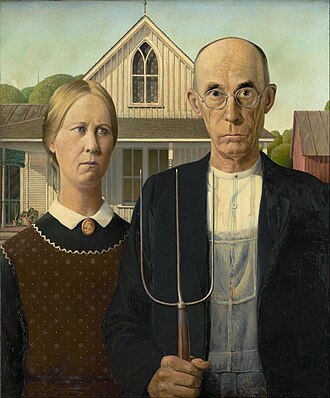It is arguably the most recognizable painting in American art. A stern, pitchfork-wielding farmer stands beside a weary-looking woman, both posed stiffly before a modest white farmhouse with a distinctive, church-like window. Grant Wood’s American Gothic (1930) has been endlessly parodied, debated, and admired. But what is this iconic work really about?
Housed at the Art Institute of Chicago, this painting is far more than a simple portrait. It is a complex and deeply personal statement about American identity, resilience, and the enduring spirit of the rural Midwest.

The Inspiration: A House and Two Faces
The story of the painting begins not with people, but with a house. In 1930, while visiting the small town of Eldon, Iowa, artist Grant Wood was captivated by a little white house with an unusual, high-arched window on its upper floor. This architectural style is known as Carpenter Gothic, which gave the painting its title. Wood said he found a “pretentious falsity” in the fancy window on such a plain farmhouse, and it sparked his imagination.
He needed figures to inhabit the house, but he didn’t just paint local farmers. Instead, he asked two people he knew well to serve as his models:
The Man: Wood’s own dentist, Dr. Byron McKeeby.
The Woman: The artist’s sister, Nan Wood Graham.
It is crucial to note that Wood did not paint them as a husband and wife, but as a father and his unmarried daughter. This context changes the entire dynamic of the painting from one of partnership to one of patriarchal protection and familial duty. Nan, in fact, was embarrassed to be depicted as a farmer’s wife and always insisted on clarifying her intended role.
Decoding the Symbolism: A Closer Look
Every element in American Gothic is deliberate and symbolic, designed to convey specific ideas about Midwestern character.
The Pitchfork: The most famous object in the painting, the three-pronged pitchfork is the heart of the composition. Wood cleverly rhymes its shape with the stitching on the man’s overalls and the structure of the Gothic window behind him. It represents the hard labor of farming, but its defensive, almost weapon-like posture also symbolizes a fierce, unyielding protection of his home, his land, and his values.
The Figures’ Expressions: The man’s gaze is direct and challenging, his mouth a firm, straight line. He is the guardian, wary of outsiders and modern influences. The woman’s gaze is more ambiguous; it is averted slightly, and her expression is a mix of weariness, patience, and perhaps a hint of longing for a world beyond the farm. A single stray curl escaping her tight bun suggests a small spark of individuality beneath her constrained exterior.
Clothing and Background: The man’s clean overalls and the woman’s colonial-print apron are not meant to be realistic farm wear, but symbols of traditional American values. They represent order, cleanliness, and a connection to a simpler, more virtuous past. Behind them, the meticulously neat porch with its carefully arranged plants reinforces this theme of order and control in a world that, during the Great Depression, felt chaotic.
A Misunderstood Masterpiece: Satire or Celebration?
When American Gothic was first exhibited, many people, especially Midwesterners, saw it as a cruel satire—a mockery of rural life by a sophisticated, European-trained artist. They saw the figures as pinched, grim, and backward.
However, Grant Wood always insisted the painting was an affectionate tribute. He intended it to be an ode to the steadfastness, dignity, and moral fortitude of the American heartland. He saw the figures not as simpletons, but as survivors, embodying the Puritan work ethic and the rugged individualism that he believed defined the American spirit, especially in the face of the Great Depression.
Key Facts at a Glance
Artist: Grant Wood (1891–1942)
Title: American Gothic
Date: 1930
Style: Regionalism / American Realism
Medium: Oil on beaverboard
Dimensions: 78 cm × 65.3 cm (30 3/4 in × 25 3/4 in)
Location: Art Institute of Chicago, Chicago, IL, USA
Legacy: The American Icon
Ultimately, the power of American Gothic lies in its ambiguity. Is it a satire? Is it an homage? The fact that it can be read both ways has allowed it to become a blank canvas onto which Americans have projected their own changing ideas about national identity, family, and tradition for nearly a century.
Recommend0 recommendationsPublished in Artworks






Responses